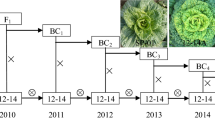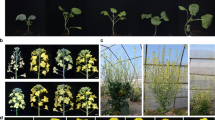Abstract
Broccoli is an important Brassica vegetable that shows obvious heterosis. The main method for hybrid broccoli production is to use cytoplasmic male sterility (CMS) and pollination by bees. Therefore, the evaluation and selection of high quality sources of CMS is important for broccoli breeding. We aimed to evaluate the effects of different CMS sources on the morphology and size of floral organs, the attractiveness to pollinators and yield of hybrid seeds. Using broccoli CMS lines generated from different CMS sources with the same maintainer lines, we studied morphophysiological characteristics of flowers, such as flower shape and size, nectar production and sugar content, as well as the number of bee visits and seed yield. The degree of bud abortion, floral organs shape, degree of flower opening, nectar production, bee visits, and hybrid yield differed in CMS lines with same recurrent parent. When the CMS source was same and the recurrent parents were different, the degrees of bud abortion were different among the CMS lines, while the flowering characteristics were similar. Generally, larger floral organs and higher volumes of nectar were associated with higher frequency of bee visits and higher seed yield. Based on the morphological characteristics and size of floral organs, nectar secretion, bee-attracting ability and hybrid yield, we selected four CMS sources suitable for future use in broccoli breeding. Our results will provide an important reference for breeding high-quality CMS lines in broccoli and provide valuable CMS sources for breeding other cruciferous crops.


Similar content being viewed by others
References
Anand IJ, Mishra PK, Rawat DS (1985) Mechanism of male sterility in B. juncea, I. Manifestation of sterility and fertility restoration. Eucaripia Crucif Newsl 10:44–46
Baker H, Baker I (1973) Amino acids in nectar and their evolutionary significance. Nature 241:543–545
Baker HG, Baker I (1982) Chemical constituents of nectar in relation to pollination mechanisms and phylogeny. In: Nitecki MH (ed) Biochemical aspects of evolutionary biology. University of Chicago Press, Chicago, pp 131–171
Baker H, Baker I (1983) A brief historical reviewof chemistry of floral nectar. In: Bentley BL (ed) The biology of nectaries. Columbia University Press, New York, pp 126–152
Davis AR, Sawhney VK, Fowke LC, Low NH (1994) Floral nectar secretion and ploidy in Brassica rapa and B napus (Brassicaceae). I. Nectary size and nectar carbohydrate production and composition. Apidology 25:602–614
De la Barrera E, Nobel PS (2004) Nectar: properties, floral aspects, and speculations on origin. Trends Plant Sci 9:65–69
Fang ZY, Sun PT, Liu YM, Yang LM, Wang XW, Zhuang M (2001) Investigation of different types of male sterility and application of dominant male sterility in cabbage. China Veg 1:6–10
Fang ZY, Liu YM, Yang LM, Wang XW, Zhuang M, Zhang YY, Sun PT (2004) Breeding and seed production technique of dominant genic male sterile line and cytoplasmic male sterile line in cabbage. Sci Agric Sin 37:717–723
Farkas A (2008) Nectar production and nectar sugar composition of three oilseed rape (Brassica napus) cultivars in Hungary. Acta Hortic 767:275–284
Fenster CB, Cheely G, Dudash MR, Reynolds RJ (2006) Nectar reward and advertisement in hummingbird-pollinated Silene virginica (Caryophyllaceae). Am J Bot 93:1800–1807
Frauen M, Noack J, Paulmann W, Grosse F (2003) Development and perspectives of MSL-hybrids in winter oilseed rape in Europe. In: Proceedings 11th international rapeseed congress, pp 316–318
Frauen M, Noack J, Girke A, Paulmann W (2006) Ten years experience of development and cultivation of winter oilseed rape hybrids in Europe based on the MSL system. In: Fu DD, Guan CY (eds) Proceedings of the 12th international rapeseed congress, vol I: Genet Breeding, Wuhan, China, 26–30 March. Science Press USA Inc, pp 39–41
Gaffney A, Allen GR, Brown PH (2011) Insect visitation to flowering hybrid carrot seed crops. New Zeal J Crop Hort 39:79–93
Galliot C, Hoballah ME, Kuhlemeier C, Stuurman J (2006) Genetics of flower size and nectar volume in Petunia pollination syndromes. Planta 225:203–212
He C, Bi Y, Jiang H, Zhou H (2005) Effects of alf alfa nectar amount and visiting bees number on alfalfa seed yield. Chin J Ecol 24:1388–1391
Hodgins KA, Barrett SCH (2008) Asymmetrical mating patterns and the evolution of biased style-morph ratios in a tristylous daffodil. Genet Res 90:3–15
Jing ZG, Pei XL, Tang Z, Liu Q, Zhang XL, Luo TK, Zhu SY (2015) Molecular identification of Ogu cytoplasmic male sterile and sequence analysis in broccoli (Brassica oleracea var. italica). Guihaia 35:239–243
Klinkhamer PGL, van der Lugt PP (2004) Pollinator service only depends on nectar production rates in sparse populations. Oecologia 140:491–494
Lohaus G, Schwerdtfeger M (2014) Comparison of sugars, iridoid glycosides and amino acids in nectar and phloem sap of Maurandya barclayana, Lophospermum erubescens, and Brassica napus. PLoS ONE 9:e87689
Luo C, Sun Y, Zhang Y, Guo Y, Klima M, Hu S (2018) Genetic investigation and cytological comparison of two genic male sterile lines 9012A and MSL in Brassica napus L. Euphytica 214:124
Masierowska ML (2003) Floral nectaries and nectar production in brown mustard (Brassica juncea) and white mustard (Sinapis alba)(Brassicaceae). Plant Syst Evol 238:97–107
Molina-Montenegro MA, Cavieres LA (2006) Effect of density and flower size on the reproductive success of Nothoscordum graminum (Liliaceae). Gayana Bot 63:109–114
Nattero J, Cocucci A, Medel R (2010) Pollinator-mediated selection in a specialized pollination system: matches and mismatches across populations. J Evol Biol 23:1957–1968
Nedić N, Mačukanović-Jocić M, Rančić D, Rørslett B, Šoštarić I, Stevanović ZD, Rosa AS, Blochtein B, Lima DK (2011) Honey bee contribution to canola pollination in Southern Brazil. Sci Agric (Piracicaba, Braz) 68:255–259
Pearson OH (1981) Nature and mechanisms of cytoplasmic male sterility in plants: a review. Hortic Sci 16:482–487
Rawat DS, Anand IJ (1979) Male sterility in Indian mustard. Indian J Genet Pl Br 39:412–414
Shu J, Liu Y, Fang Z, Yang L, Zhang L, Zhuang M, Zhang Y, Li Z, Sun P (2014) Study on the floral characteristics and structure in two types of male sterile lines of broccoli (Brassica oleracea var. italica). J Plant Genet Resour 15:113–119
Shu JS, Liu YM, Li ZS, Zhang LL, Fang ZY, Yang LM, Zhuang M, Zhang YY, Sun PT (2015a) Effect of different pruning methods on flowering and fruiting characteristics between different types of male sterile lines in broccoli seed plants. Acta Hortic Sin 42:689–696
Shu J, Liu Y, Li Z, Zhang L, Fang Z, Yang L, Zhuang M, Zhang Y, Lv H (2015b) Organelle simple sequence repeat markers help to distinguish carpelloid stamen and normal cytoplasmic male sterile sources in broccoli. PLoS ONE 10:e0138750
Shu J, Liu Y, Li Z, Zhang L, Fang Z, Yang L, Zhuang M, Zhang Y, Lv H (2016) Detection of the diversity of cytoplasmic male sterility sources in broccoli (Brassica oleracea var. italica) using mitochondrial markers. Front Plant Sci 7:927
Stuurman J, Hoballah ME, Broger L, Moore J, Basten C, Kuhlemeier C (2004) Dissection of floral pollination syndromes in petunia. Genetics 168:1585–1599
Thompson KF (1972) Cytoplasmic male sterility in oil-seed rape. Heredity 29:253–257
Walley PG, Carder J, Skipper E, Mathas E, Lynn J, Pink D, Buchanan-Wollaston V (2012) A new broccoli × broccoli immortal mapping population and framework genetic map: tools for breeders and complex trait analysis. Theor Appl Genet 124:467–484
Wan ZJ, Jing B, Tu JX, Ma CZ, Shen JX, Yi B, Wen J, Huang T, Wang XJ, Fu TD (2008) Genetic characterization of a new cytoplasmic male sterility system (hau) in Brassica juncea and its transfer to B. napus. Theor Appl Genet 116:355–362
Wang QB, Fang ZY, Zhang YY, Liu YM, Yang LM, Zhuang M, Sun PT (2011) The floral and seed setting characteristics in two types of male sterile lines of cabbage (Brassica oleracea L. var. capitate). Acta Hortic Sin 38:61–68
Yang GS, Fu TD (1990) The inheritance of Polima cytoplasmic male sterility in Brassica napus. Plant Breed 104:121–124
Zhang Y, Wang XJ, Li CQ, Song HY, Ren XS, Si J (2010) Molecular identification of Brassica oleracea CMS and the morphology response of flower to nuclear background. Acta Hortic Sin 37:915–922
Zhu YT (2010) Comparative research on the morphology and biochemical characteristics and cytoplast germplasm of polima CMS and Shan 2A CMS in Brassica napus L. Ph. D dissertations, Northwest A & F University
Zhu YY, Yao WY, Zhang SQ, Ling C, Shen FY, Gong J, Wu XG, Jin HJ (1998) Breeding and utilization of male sterile lines with Ogura cytoplasm in cabbage. Acta Agric Shanghai 14:19–24
Zhu YY, Yao WY, Wu XG, Gong J, Shen FY, Jin HJ (1999) Effect of genetic background on seeding capability of cytoplasmic male sterile materials in broccoli. Acta Agric Shanghai 15:28–30
Acknowledgements
This work was supported by National Natural Science Foundation of China (Grant No. 31372067), China Agriculture Research System (Grant No. CARS-25-A), the Key Projects in the National Science and Technology Pillar Program of China (Grant No. 2013BAD01B04), the Key Laboratory of Biology and Genetic Improvement of Horticultural Crops, Ministry of Agriculture, P. R. China, and the Science and Technology Innovation Program of the Chinese Academy of Agricultural Sciences (Grant No. CAAS-ASTIP-IVFCAAS). We thank Huw Tyson, PhD, from Liwen Bianji, Edanz Editing China (www.liwenbianji.cn/ac), for editing the English text of a draft of this manuscript.
Author information
Authors and Affiliations
Contributions
YML and JSS conceived and designed the study. JSS and LLZ performed the experiments. JSS and LLZ analyzed the data. JSS and LLZ prepared the manuscript, YML and JSS improved the manuscript. YML, ZYF, LMY, MZ, YYZ, ZSL and HHL contributed reagents and materials. YML provided guidance on the whole study. All authors read and approved the final manuscript.
Corresponding author
Ethics declarations
Conflict of interest
The authors declare that they have no conflict of interest.
Additional information
Publisher's Note
Springer Nature remains neutral with regard to jurisdictional claims in published maps and institutional affiliations.
Rights and permissions
About this article
Cite this article
Shu, J., Liu, Y., Zhang, L. et al. Evaluation and selection of sources of cytoplasmic male sterility in broccoli. Euphytica 215, 125 (2019). https://doi.org/10.1007/s10681-019-2453-y
Received:
Accepted:
Published:
DOI: https://doi.org/10.1007/s10681-019-2453-y




